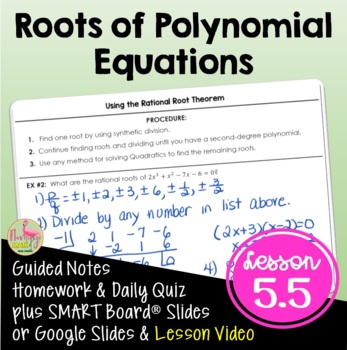Roots of Polynomial Equations (Algebra 2 - Unit 5)
- Zip
What educators are saying
Also included in
- This MEGA Bundle for Unit 5 Polynomial Functions and Equations includes foldables, guided notes, homework assignments, daily content quizzes, mid-unit and end-unit assessments, review assignments, and cooperative activities for your Algebra 2 Honors students. The unit includes 9 lessons which arePrice $64.00Original Price $80.00Save $16.00
- ALGEBRA 2 CURRICULUM MEGA BUNDLE What does the curriculum include?This resource is designed for students enrolled in ALGEBRA 2 HONORS. You will find more than 1900+ pages of instructional content (warm-ups, Guided Notes and Foldables, Google Slides, SMART Board slides, video lessons, homework, dailPrice $535.00Original Price $675.44Save $140.44
Description
Roots of Polynomial Equations Algebra 2 Lesson:
Your Pre-AP Algebra 2 Honors students will solve polynomial equations using the Rational Root Theorem for real, irrational and complex zeros in this Unit 5 lesson on Polynomial Functions. #distancelearningtpt
What is included in this resource?
⭐ Guided Student Notes
⭐ Google Slides®
⭐ Fully-editable SMART Board® Slides
⭐ Homework/Practice assignment
⭐ Lesson Warm-Up (or exit ticket)
⭐Daily Content Quiz (homework check)
⭐ Video Lesson Link for Distance Learning - Flipped Classroom models
⭐ Full solution set
Students will be able to:
★ Solve equations using the Rational Root Theorem
★ Write polynomials given roots of the function
★ Use Descartes' Rule of Signs as a tool for determining possible roots for a function. When combined with a graphing calculator, Descartes' Rule of Signs can be verified for a more thorough understanding of solutions
The unit includes the following topics:
2) Polynomials, Linear Factors, and Zeros
3) Solving Polynomial Equations
5) Theorems About Roots of Polynomials
6) The Fundamental Theorem of Algebra
8) Polynomial Models in the Real World
You may also be interested in:
Polynomial Sort and Match Activity
Polynomial Tournament Review Activity
Complex Roots Task Cards with QR Codes
Activities & Assessments Bundle
Here's a FREE item that complements the unit:
Remainder and Factor Theorems FREEBIE
****************************************************************
I LOVE FEEDBACK
Remember to leave feedback and you will earn points toward FREE TPT purchases. I love that feedback!
Also, follow me to be notified about my new products, sales, updates, and FREEBIES!
If you have any questions, comments or special requests
please contact me by email at: jean@flamingomath.com
Thanks for shopping in my store!
Jean Adams




